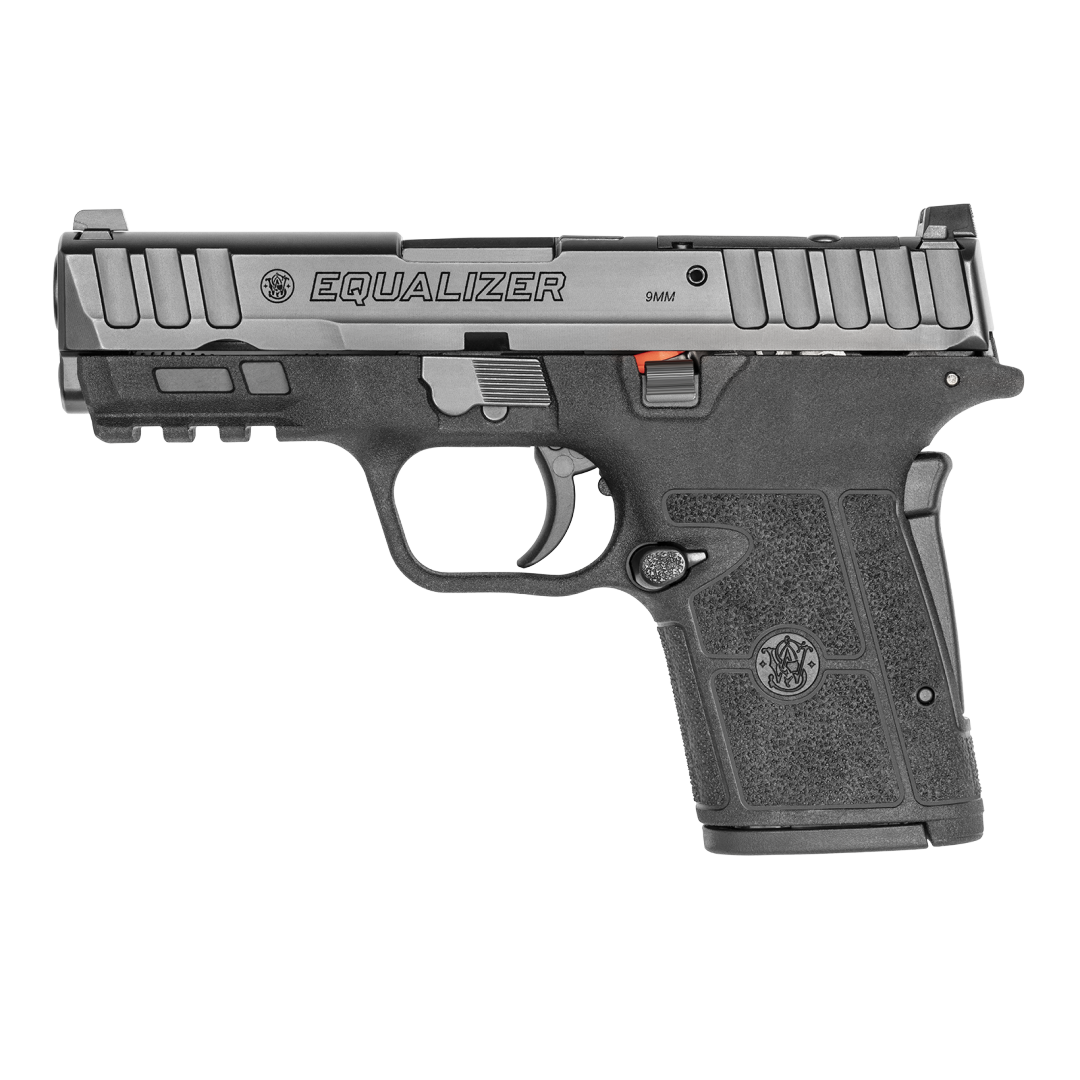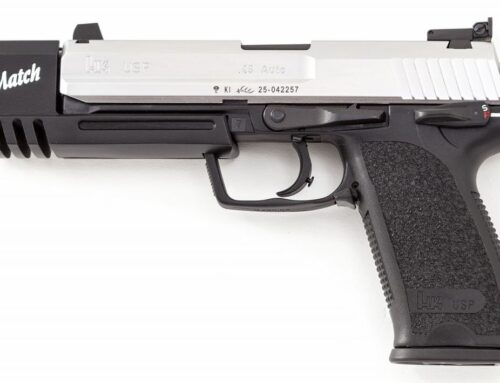High capacity subcompact pistols are all the rage lately. Ever since Sig revealed the double stack P365 there has been a lot of catching up from the rest of the market. Smith & Wesson wasn’t too far behind with the M&P Shield Plus series which updated the M&P Shield 2.0 series but they didn’t stop there. Next up was the external hammer fired CSX. Now there’s the “Equalizer” which at first glance might leave some wondering what makes it different? In short, S&W has apparently dropped the “EZ” name but internally the Equalizer is nothing more than the spiritual successor to the much longer winded M&P Shield EZ series.
Unlike the EZ which started with the .380 (which I still believe is the more ideal choice between these two) the Equalizer is currently only available in 9mm, and I suspect the reason behind this lies with the magazine. At its core the Equalizer is simply a 9mm EZ with some new bells and whistles, the most notable upgrade being the use of the Shield Plus’s double stack magazine. Smith & Wesson already have the mag designed and ready to go so why not make further use of it? The same cannot be said for a double stack .380 magazine, hence why I believe the Equalizer did not carry over a second caliber option. I’m curious to see what might come of a .30 Super Carry configuration, the third cartridge which the EZ can be found in.
As a side note the CSX uses its own magazine which is both too short and too wide to fit into either the Equalizer or the Shield Plus.
One drawback of switching to a double stack mag, and an existing model, is that you lose the “cheater” tabs which aided in loading the EZ’s single stack magazines. In addition, due to being a subcompact some speed loaders like the Maglula may not work well with the shorter mags in general. The Equalizer can be fed 10, 13, and 15 round meals, which is certainly a nice benefit. Otherwise the EZ functionality remains intact with an easier to rack slide and the same bottom hinged grip safety.
In fact, if you look closer you’ll see more design cues from the 9mm EZ. This is because it’s the exact same gun given an external makeover. Setting aside the magazine differences I took a 9mm EZ and an Equalizer and swapped slides onto each. Both fit their kin perfectly, however the Equalizer uses a different hammer shape which is a little smaller than the EZ. While the EZ slide will fire and function on an Equalizer lower the Equalizer upper will fit but not fire on an EZ lower.
There is more than being able to carry more rounds over the EZ series but none of it is ground-breaking. The next notable change is the addition of an optics plate as standard. A quick search on S&W’s website holds an interesting tidbit, when “building” an EZ pistol there is an option for being Optic Ready but both of the options are “No.” The grip has new texturing and is slightly shorter by default than the EZ due to the double stack capacity, the slide has different cuts, and… That’s it. More rounds per mag, option to install a pistol optic, Bob’s your uncle. At first glance many of the parts seem compatible between the two. The magazine release appears to have been lifted straight from the Shield Plus while the trigger, slide catch, and grip safety all seem directly off of the EZ.
Now, I’m not dissing on the Equalizer. Everything I’ve described seems like a natural update to the EZ platform. The handgun looks great, handles the same as the 9mm EZ which was already pretty solid, and it gives you a little more where you might want or need it over the previous single stack model. It’s just… Well. Marketing. It isn’t the EZ Plus or an EZ 2.0 or an EZ High Capacity, or whatever. It’s the “Equalizer.” What exactly is it equalizing? Magazine capacity? Such a name plays it up as being this amazing new offering when it’s nothing more than a reskin, a kitbash of three other guns. I find such a naming convention both misleading and playing into the “Hellcat Hype” where the firearm’s name is used as one of its major selling points. It’s happening far too often these days.
Yes I’m looking at you, Hellion.
Many of these companies should probably start to take themselves a teensy bit less seriously. Still, it IS a lot easier to say than “S&W M&P 2.0 Shield EZ 9mm” so I’ll grant them that much. “Equalizer.” Boom. One word names help, even if they’re an acronym.
In addition to the grip safety the Equalizer can be had with and without a manual thumb safety, a feature which appears to be mandatory on the 9mm EZ according to their website builder. This Builder thing piqued my curiosity though. I attempted to create a Shield Plus, 9mm EZ, and Equalizer with as similar a feature set as possible to compare their listed MSRP.
The Shield Plus, with or without thumb safety and optics mount, comes in at $549.00.
The Equalizer, with or without thumb safety and optics mount, has an MSRP of $599.00.
The 9mm Shield EZ, with thumb safety and no optics mount, comes in at $605.00.
Somehow the Equalizer offers more than the 9mm EZ at a slightly lower price point. Interesting! I also wonder if the EZ line is planning to stick around or fade out now that a new version is here.
And now for the big question: How does it shoot? I’m going to do something fun and give the Equalizer a direct heads up versus the Shield Plus, the EZ 9mm, and just because I can, the CSX. Let’s just throw all of S&W’s 9mm sub guns into a head to head comparison!
Why yes, I do enjoy my work. What tipped it off?
Up front I noticed the Equalizer’s grip dimensions are exactly the same as the Shield Plus. The Equalizer’s new slide serrations are quite sharp which is one of the major drawbacks to having those larger chunkier serrations rather than the older style which looks more like a handheld file. I did not enjoy manipulating the slide, though fortunately the Equalizer shares the EZ’s lighter pull weight so I didn’t have to fight with it too much.
What should come as no surprise is the Shield Plus, EZ 9, and Equalizer all handle exactly the same. They’re right around the same size, same weight, even the same build, so understandably there is very little difference in handling. The CSX comes in last place here but only by a small amount, having what I feel is the worst trigger of the bunch along with a hair more snap. This might be due to the metal frame sending more of the recoil impulse directly into your palm. Before you point out that metal is heavier and should absorb more of this energy I’ll point out the CSX weighs almost the same as the other three.
As far as triggers go I would place the Shield Plus next. The overall length of travel may be shorter than the EZ 9 or Equalizer but its shorter travel came at the price of feeling heavier and grittier. It’s also worth noting the Shield Plus has a more vertical (but not straight) trigger with less rounded edges whereas the EZ 9 and Equalizer’s shared trigger is both curved and rounded, which I much prefer.
Here’s the kicker, and this came as a surprise to me: Out of the four I like the Equalizer the best. It has all of the benefits of both the Shield Plus and the EZ 9 with what I feel is the best stock trigger out of the group. Capacity is dead-on tied with the Shield Plus but you gain an easier to manipulate slide. I’m even a fan of the grip safety so long as they don’t go with the sharp edged aluminum versions from the Performance Center .380’s.
Digging deeper, there may be another factor at play. Lighter guns are better to carry but less enjoyable to shoot. Diving into S&W’s website again reveals some curious details.
The Shield Plus weighs a svelte 19.3 ounces.
The CSX is right behind it at 19.5 ounces.
The EZ 9mm is 23.3 ounces. I’ll bet part of having a lighter recoil spring is due to having a heavier slide!
The Equalizer…is 22.9 ounces. Wait, what? The double stack version is LIGHTER than the EZ?! What sorcery is this??
I’ve got nothing.
Smith & Wesson has made some great carry gun options but I find the Equalizer to be the best of their nines. There, I’ve said it. If you don’t like the grip safety and/or prefer striker fired or want to go for full on concealed then go with the Shield Plus, you’ll gain a slightly shorter and lighter carry option but lose the Picatinny accessory rail. Compared to the EZ 9 the only thing you’re losing is cheater tabs on the mag which aren’t the most comfortable to use in the first place. Compared to the CSX you still have a hammer fired gun but with the hammer concealed, a more comfortable shooting experience, a better trigger, better magazine compatibility and an accessory rail, but at the cost of a slightly larger and heavier firearm.
Maybe what’s really being Equalized is S&W’s subcompact product line since this gun borrowed features from everything else. Boom.








